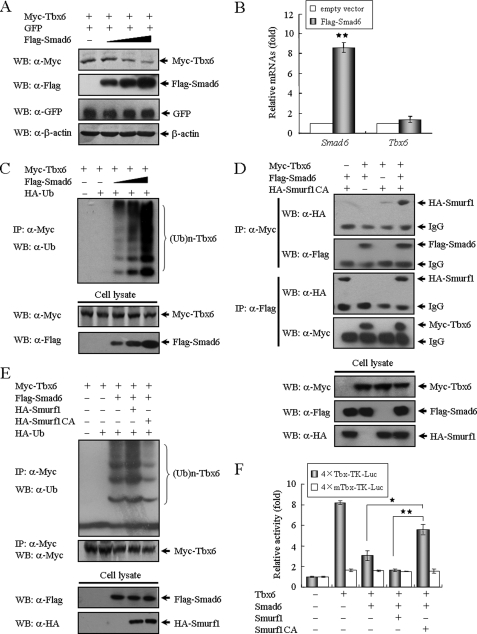FIGURE 4.
Smad6 mediates Tbx6 ubiquitination and proteasomal degradation. A, Smad6 induces Tbx6 degradation in a dose-dependent manner. Tbx6 expression construct (100 ng) was co-transfected with increasing amounts of Smad6 (0, 0.1, 0.2, and 0.4 μg/well in a 12-well plate; represented by the black triangle) expression plasmid into HEK 293T cells. In each transfection, an equal amount of green fluorescent protein (GFP) expression plasmid (50 ng) was included as an internal control. The protein levels of Tbx6 and Smad6 in whole cell lysates were detected by Western blotting (WB). β-Actin was used as a loading control. B, overexpression of Smad6 has no obvious effect on the mRNA level of Tbx6. TT-D6 cells transfected with control or Smad6 expression plasmids were subjected to RT-PCR analysis for related gene expression. The relative value for each target gene was normalized to the average intensity of the endogenous control gene, GAPDH. **, p < 0.01. C, Smad6 mediates Tbx6 ubiquitination and proteasomal degradation in a dose-dependent manner. 293T cells were transfected with expression constructs in the indicated combinations. After 24 h of transfection, cells were treated with 10 μm MG132 for 4 h before harvesting. Immunoprecipitation (IP) was performed using anti-Myc antibody and followed by Western blotting using anti-ubiquitin antibody. D, Tbx6 forms a ternary complex with Smad6 and Smurf1. Protein extracts from 293T cells transfected with the indicated plasmids were immunoprecipitated with anti-Myc or anti-FLAG antibodies and analyzed by Western blotting using the indicated antibodies. E, Smurf1 promotes Smad6-mediated Tbx6 ubiquitination. Tbx6 ubiquitination was assessed as described above. HA, hemagglutinin; Ub, ubiquitin. F, Smurf1 cooperates with Smad6 to dramatically reduce Tbx6-dependent transcriptional activity. TT-D6 cells were co-transfected with 4×Tbx-TK or 4×mTbx-TK reporter and additional expression constructs including Tbx6, Smad6, Smurf1, and its inactive mutant, in different combinations as indicated. *, p < 0.05; **, p < 0.01 using Student's t test.

